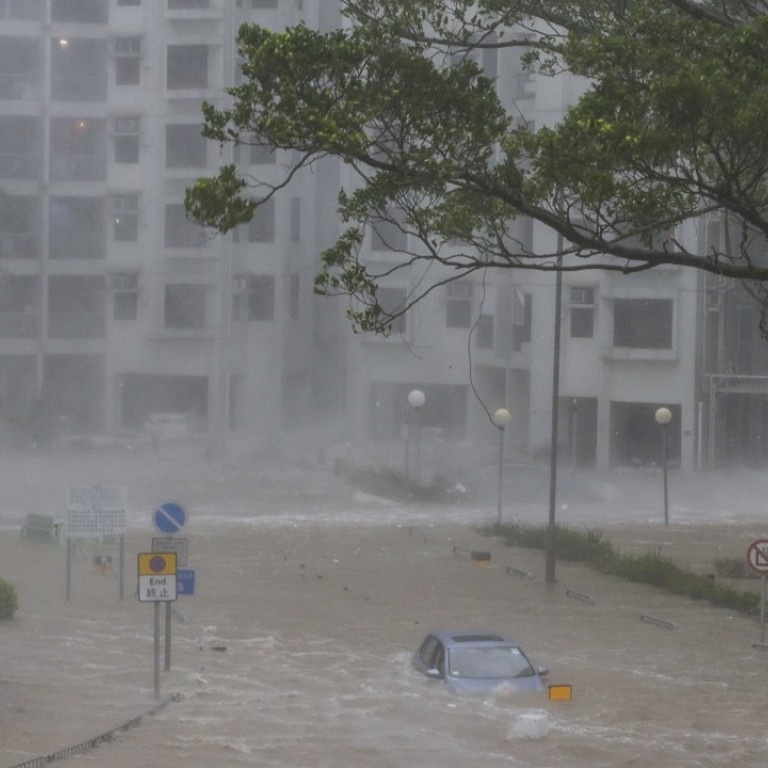
Insurance claims could reach all-time high in 2018 as climate change increases severity of natural disasters
- Insurance losses from Typhoon Mangkhut, which was not included in Allianz’s report, to cost sector up to US$2 billion in China, Hong Kong and Macau
- Claims resulting from storm damage in Hong Kong top the list for Allianz
This year could be the most expensive on record for insurers as climate change increases the severity and volatility of natural catastrophes worldwide, while storm damage tops the list of corporate claims in Hong Kong, according to a leading insurer.
Global insured losses from natural disasters this year – from wildfires in California, to floods in Sydney and super typhoons in Asia – will at least equal if not exceed the US$144 billion in 2017, according to Allianz.
“Scientists predict that the storms and typhoons will continue to get stronger and more frequent as a result of global warming – that is the trend we are seeing now,” said Patrick Zeng, CEO of Hong Kong and Greater China at Allianz Global Corporate & Specialty (AGCS), in an interview with the Post, adding that claims payout will get bigger and bigger.

In Hong Kong, storm damage and losses were the top cause of corporate insurance claims from July 2013 to 2018, according to Allianz’s 2018 Global Claims Review released on Thursday. These accounted for 38 per cent of the value of the 1,169 claims analysed, totalling €22.4 million (US$25.4 million), despite making up just 10 per cent of the actual number.
Claims due to property damage and business disruption from the five typhoons that hit Hong Kong between June and October 2017 reached HK$935 million (US$120 million), with Typhoon Hato accounting for almost HK$858 million, according to the Hong Kong Federation of Insurers.
In September, Hong Kong was hit with its strongest tropical storm to date: Typhoon Mangkhut. The federation is currently conducting a survey on the loss it caused and expects it to have generated more claims than Hato.
Insurance losses from Typhoon Mangkhut alone, which are not included in Allianz’s report, are estimated to be between US$1 billion and US$2 billion for China, Hong Kong and Macau, according to Zeng.

Natural catastrophes rank as Hong Kong’s third highest risk in 2018, down from first place in 2017. Business disruption, which typhoons contribute to, has taken first place.
Meanwhile, storms, not unique to Hong Kong, were the only natural catastrophe to appear in Allianz’s top 10 causes of loss of insurance claims globally, coming in at fourth place and accounting for 7 per cent by value.
In September, for example, Japan was hit by Typhoon Jebi, its strongest since 1993 with winds of over 200kph, while in October Hurricane Michael was one of the top four most powerful to hit the US.
Though the frequency of natural catastrophe related claims have not increased globally, said Allianz’s Zeng, their value has.

An increasing severity and volatility of catastrophes – demonstrated by the strength of Typhoon Mangkhut – combined with a higher economic activity which creates more expensive, denser buildings as populations and businesses expand, have made the claims larger in size, particularly in Asia, according to the report.
“Natural catastrophe losses in Asia are becoming more relevant as businesses invest in regions with significant exposures to storms, flooding and earthquakes, and as insurers like AGCS follow their clients into these markets,” said Raymond Hogendoorn, property and engineering claims specialist at AGCS.
Insurance Authority launches platform to help insurers tap belt and road projects
Increasing severity of natural catastrophes is a high concern, noted Duncan Southcott, a marine claims specialist at AGCS.
In 2017, hurricanes Harvey, Irma and Maria caused an estimated US$1 billion of insured losses for the yacht market in the US alone, making the three storms feature among the top 10 marine losses of the past decade, according to Allianz.
“With growing concentrations of insured assets in catastrophe-exposed regions, storms, floods and earthquakes have the potential to generate very large and complex claims for marine insurers,” Southcott said.

While natural disasters are becoming more of an issue, events caused by human or technical errors remain the top causes of loss for the insurance industry, accounting for 87 per cent of all claims.
Fire and explosion incidents top the list for the industry over the past five years, making up 24 per cent of value of all insurance claims and causing over €14 billion of losses, with an average claim of almost €1.5 million.
What’s the secret to still being fit enough to work at 95? Ask insurance pro William Woo Shau-kee, who has still got game
In China, for example, fires and explosions were the most claimed category, which accounted for 65 per cent of 5,209 analysed claims in China since 2013. One was the biggest incidents was the series of explosions at the container storage station of Tianjin port in August 2015, which killed at least 165 people and injured hundreds.

